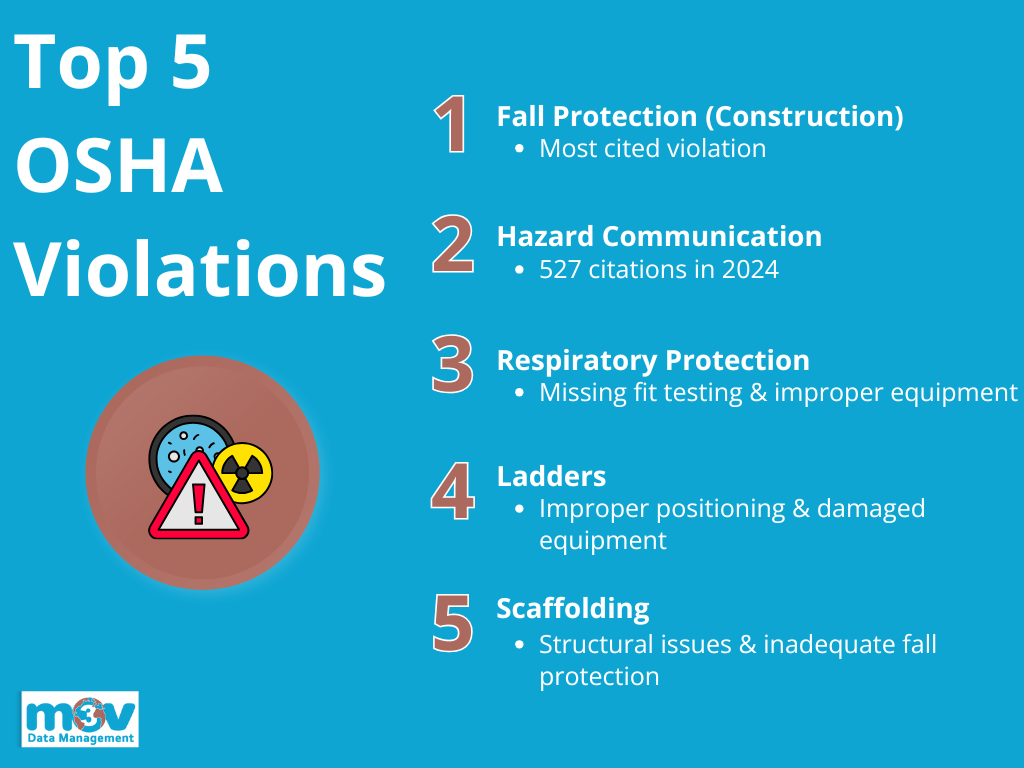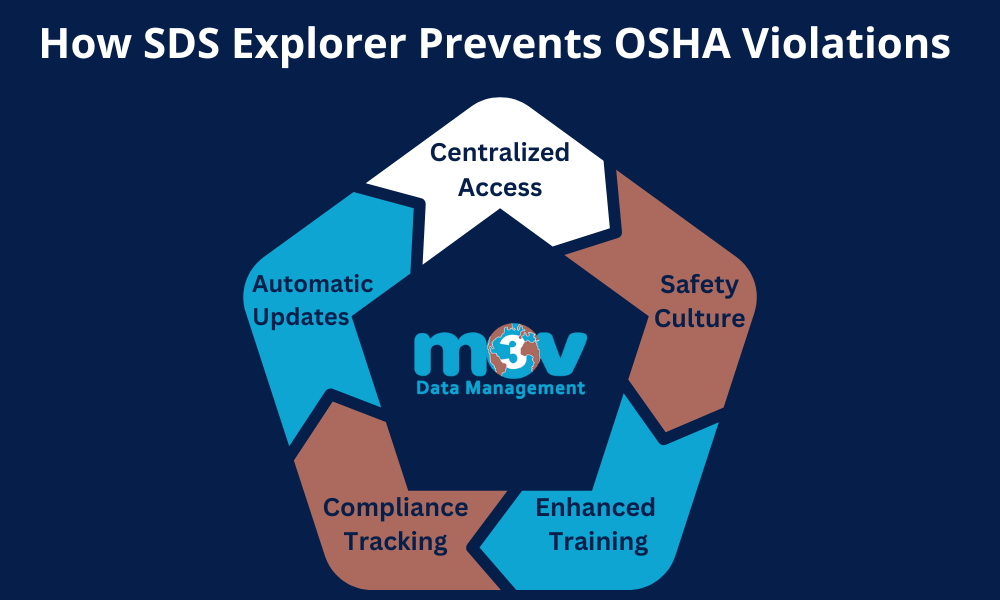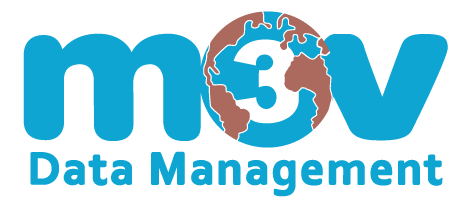The Occupational Safety and Health Administration (OSHA) protects millions of workers across the United States by establishing and enforcing workplace safety standards. However, safety violations remain a significant issue, leading to workplace accidents, serious physical harm, and costly penalties for employers.
The top 5 workplace safety violations that consistently lead OSHA citations are:
- Fall Protection (Construction) – Inadequate guardrails, missing safety harnesses, or improper scaffold construction
- Hazard Communication (General Industry) – Missing or outdated Safety Data Sheets and incomplete employee training
- Respiratory Protection – Failing to establish complete respiratory programs or provide appropriate PPE
- Ladders (Construction) – Improper positioning, exceeding weight limits, or using damaged equipment
- Scaffolding (Construction) – Structural inadequacies, improper assembly, and insufficient fall protection
OSHA violations, ranging from other-than-serious violations to willful violations, can result in maximum penalty amounts that may reach tens of thousands of dollars per citation. By implementing effective SDS management and complete EH&S software solutions, employers can significantly reduce their risk of citations while creating a safer work environment for their teams.
Why OSHA Violations Matter for Employers
An OSHA violation represents more than just a regulatory misstep—it signals potential threats to employee safety and your organization’s financial stability.
Types of OSHA Violations and Penalties
- Serious violations: Up to $16,550 per violation for hazards that could cause serious physical harm or death
- If the violation is classified as “willful” or “repeated,” the maximum penalty can increase to $165,514 per violation.
- Businesses that fail to correct a cited hazard by the deadline can face additional fines of up to $16,550 for every day the violation continues.
Consequences Beyond Financial Penalties
- Higher insurance costs and coverage challenges – OSHA violations heavily influence insurance costs. A single major infraction can spike premiums, while repeated or ongoing issues may push companies into costly high-risk pools. Workers’ compensation carriers may also require added safety measures, outside audits, or limit coverage for certain operations and locations.
- Legal liability exposure from workplace injuries
- Damaged professional reputation
- Additional regulatory scrutiny and more frequent inspections
Prevention Strategy
The most effective approach involves proactive compliance through systematic workplace safety programs, including specialized EH&S software and organized SDS management.

The Top 5 OSHA Violations in the Workplace
According to OSHA’s most recent “Top 10 Most Cited Standards” report, five violations consistently lead workplace safety citations across various industries. By understanding these prevalent violations and their link to chemical safety management, employers can create focused strategies to prevent them.
1. Fall Protection (Construction – 1926.501)
Fall protection violations remain the most frequently cited OSHA standard, accounting for thousands of citations annually in construction environments. These violations often result from inadequate guardrails, missing safety harnesses, or improper scaffold construction around elevated work areas.
The serious hazard posed by fall protection failures extends beyond immediate injury risks. When workers handle hazardous chemicals at elevation, falls can create secondary exposure incidents affecting multiple employees. Proper SDS management ensures workers understand chemical hazards in fall zones, enabling better emergency response and reducing compound risks during workplace accidents.
2. Hazard Communication (General Industry – 1910.1200)
Hazard Communication violations represent one of the most preventable yet persistent workplace safety challenges. In fiscal year 2024, OSHA issued 527 citations for HazCom violations, resulting in penalties totaling approximately $865,864.
Under OSHA’s HazCom standard, employers must maintain current Safety Data Sheets (SDS) for all hazardous chemicals, provide complete employee training, and ensure workers can access safety information when needed.
Common HazCom violations include:
- Missing or outdated SDSs for chemicals currently in use
- Complete employee training on chemical hazards and protective measures
- Inaccessible safety information during emergencies or routine operations
- Improper chemical labeling that fails to communicate hazard information
- Incomplete hazard assessments for workplace chemical inventories
The complexity of maintaining HazCom compliance increases exponentially with facility size and chemical diversity. Manufacturing facilities might manage hundreds of different chemicals across multiple departments, while healthcare organizations handle pharmaceuticals, cleaning agents, and laboratory chemicals requiring different safety protocols.
How M3V Enhances HazCom Compliance for Your Team
M3V’s SDS Explorer transforms HazCom compliance from a burden into a competitive advantage. The platform automatically updates Safety Data Sheets when manufacturers revise formulations, ensuring your team always accesses current safety information. During OSHA inspections, inspectors can immediately verify SDS availability and currency, demonstrating your commitment to employee safety.
The software’s intuitive search functionality allows workers to quickly locate specific chemical information during emergencies, reducing response times and improving safety outcomes. Rather than searching through filing cabinets or outdated databases, employees can access complete safety data from any connected device, supporting both routine operations and emergency response procedures.
Integration with employee training programs ensures consistent HazCom education across your organization. The platform tracks training completion, identifies knowledge gaps, and provides updated information when chemical inventories change, maintaining continuous compliance with OSHA requirements.
3. Respiratory Protection (1910.134)
Respiratory protection violations frequently occur when employers fail to establish complete respiratory programs or provide appropriate personal protective equipment for chemical exposures. OSHA inspectors regularly cite facilities for missing fit testing, inadequate hazard assessments, or improper respirator selection.
Effective respiratory protection depends on accurate chemical hazard information found in Safety Data Sheets. SDSs specify required protection levels, compatible respirator types, and exposure limits that determine when respiratory protection becomes mandatory. M3V’s SDS management platform makes this critical information immediately accessible, helping safety professionals select appropriate protective equipment and maintain compliant respiratory programs.
4. Ladders (Construction – 1926.1053)
Ladder safety violations contribute significantly to workplace injuries, particularly when combined with chemical handling activities. Improper ladder positioning, exceeding weight limits, or using damaged equipment creates serious safety hazards that OSHA inspectors consistently identify during construction site visits.
When workers transport or access chemicals stored at elevation, ladder safety becomes interconnected with chemical safety management. SDS information helps determine appropriate handling procedures for chemicals accessed via ladders, including weight considerations, compatibility requirements, and emergency response procedures. Proper SDS management complements ladder safety protocols by ensuring workers understand material handling requirements before beginning elevated work.
5. Scaffolding (Construction – 1926.451)
Scaffolding violations encompass structural inadequacies, improper assembly, and insufficient fall protection systems. These workplace safety violations become particularly dangerous when scaffolds support chemical handling operations or storage systems.
Complete SDS management supports scaffolding safety by providing critical information about materials stored or used on elevated platforms. Understanding chemical compatibility, weight specifications, and emergency procedures helps prevent unsafe conditions that could compromise scaffold integrity or worker safety. This integrated approach to chemical and structural safety reduces multiple violation risks simultaneously.

How SDS Management Prevents OSHA Violations
Effective Safety Data Sheet management serves as the foundation for complete workplace safety compliance, addressing multiple violation categories while simplifying regulatory requirements for busy EH&S professionals.
Centralized Access During Inspections: When OSHA inspectors arrive at your facility, they expect immediate access to current Safety Data Sheets for all hazardous chemicals. M3V’s SDS Explorer provides:
- Instant access to organized, searchable safety data
- Compliance readiness demonstration that reduces inspection stress
- Elimination of frantic searches for missing paperwork
Automatic Updates Prevent Citation Risks: Chemical manufacturers regularly update Safety Data Sheets to reflect new research, regulatory changes, or formulation modifications. Manual tracking systems frequently miss these updates, creating compliance gaps that result in citations for outdated information. Automated SDS management ensures your safety data remains current without requiring constant manual monitoring.
Enhanced Employee Training Support: OSHA standard requires complete employee training on chemical hazards, but maintaining effective programs becomes challenging without organized safety information. SDS management platforms support training initiatives by providing:
- Easy access to hazard information, exposure procedures, and emergency protocols
- Improved training quality through accessible safety data
- Demonstrated compliance commitment to regulatory inspectors
Beyond individual compliance requirements, effective SDS management cultivates a strong workplace safety culture where employees understand hazards, access necessary information, and follow established safety protocols. This cultural transformation reduces violation risks across all OSHA standards, not just chemical-specific requirements.

Partnering with M3V for OSHA Compliance
M3V helps organizations across manufacturing, healthcare, education, and government sectors transform OSHA compliance from a reactive burden into a proactive competitive advantage. Our expert-driven solutions combine user-friendly design with powerful functionality, making complete safety management accessible to teams without extensive technical expertise.
The platform’s flexibility accommodates diverse organizational needs, from small facilities managing basic chemical inventories to complex operations requiring sophisticated regulatory tracking. Exceptional customer support ensures your team maximizes software capabilities while maintaining efficient compliance workflows that actually improve rather than complicate daily operations.
By choosing M3V’s integrated EH&S solutions, you’re investing in proven tools that address the root causes of common OSHA violations while supporting long-term safety culture development throughout your organization.
Take Action Before OSHA Inspectors Arrive
Don’t wait for an OSHA inspection to discover compliance gaps in your workplace safety program. Proactive safety management protects your employees, reduces regulatory risks, and demonstrates your commitment to maintaining the highest safety standards.
Discover how M3V’s SDS Explorer can help your team avoid OSHA violations and keep your workplace safe. Request a quote today and see how easy complete safety management can be.




